Julie Musil's Blog, page 8
May 7, 2014
Enjoy the "Now" of Your Writing Journey #IWSG

Welcome, insecure writers! Wanna join the group? Clicky here and sign up. And don't forget to tell yourself how smart you are for doing so :)
Are you insecure about where you are on your writing journey? I feel ya. But I'll share a little trick in just a minute.
My oldest son is finishing up his junior year in high school. He's been researching universities since 9th grade, and lately we've been going on campus visits. He's even looked ahead to internships and dream companies he'd like to work for or emulate. He's super excited about college, and he's kind of a motivated guy.
One night, while juggling all this research and current assignments, he said, "I think I'm looking too far into the future." I told him I thought it was fine to look far into the future, as long as he enjoys the "now." He still has summer, and his senior year--with Friday night football games, prom, and all the other fun times he'll have before graduation.
It reminded me how writers seem to look beyond the now and focus on the future. When I get an agent. When I sign that book deal. When I reach the bestseller list.
I'll let you in on a little secret that's helped me remain calm and content even though I'm a busy wife, mom, author, and publisher: I enjoy the now . Right now, where I'm at on my writing journey.
Yes, I've looked ahead to the agent, the book deal, and all the other milestones writers dream about. But I've also made it a habit to focus on the progress I've made, and all the joy I've felt with each accomplishment. Where I'm at right now is pretty darn good. But it was also good when I was first learning this writing thing...and it was good when I finished my first crappy novel...and it was good when I signed with my agent...and it was good when I indie published.
What's that quote? Life is what happens when we're busy making plans.
What does my son's future hold? I have no idea. What does my own future hold? Also, no idea. But when life gets hectic, my solution is simple: take a deep breath, plan for the future, but enjoy the now.
That's my little secret! Do you focus too much on the future? Or do you stop, look around, and enjoy the now? Any tips you can share?
Published on May 07, 2014 04:00
April 30, 2014
Writing Retreats: The Benefits, and How You Can Plan One Without Going Broke

Friends, today we have an awesome guest post by a super nice dude, Dean K. Miller. He's here to chat about writing retreats. But first, there are a couple of things I wanted to mention:
Big congratulations to all of you brave folks who conquered the A-Z Challenge. *applauds loudly*In case you missed it, be sure to check out my guest post over at Janice Hardy's blog, Fiction University. I tackled the subject Are print books necessary in the digital age?
Now, Dean Miller shares with us why writing retreats are priceless, and how we too can plan one without draining the bank. Take it away, Dean!
Writers on RetreatNo, we aren’t circling the wagons or high-tailing it back to the fort for safety. With the world of publishing opening up like the Red Sea, writers are coming out in droves. And a vast majority is producing some high quality work.But where do we find the time to hammer out novel after novel? I mean, really, with a day job, family, fly fishing, kids in school . . . the list and its demand on our time is nearly endless. One way to squirrel away precious writing time is to take a writing retreat. Yes, we all dream of countless hours of uninterrupted writing, prepared meals, and nature’s harmonious sounds in the background while we tap away on our keyboards, producing chapter after chapter of splendorous verbiage.I already hear you lamenting (in your loudest, four-year-old, whiny voice.) “But that costs a lot of money.”Yes, it certainly can. But it can be worth it. For my first retreat I paid $345.00, which included a single room, two four-hour days of fly fishing and nearly three days of uninterrupted writing (except to eat and refill my wine glass.) I skipped the movie night and at the end of the weekend I had added over 15,000 words to my novel.However, my first writing sabbatical took place on a trip to Houston, TX with my daughter for a swim meet. We had budgeted for this and I took along my laptop. In between swim sessions I wrote for several hours. To learn more about this journey, visit Leanne Dyck’s great blog on August 15th.But there are other options, many less expensive and even a few for free. Here are a few creative ways to find yourself with hours of quality writing time.Amtrak’s Train Writing Residencies: Amtrak is offering 24 writing residencies free of charge. They are accepting submissions and are awarding free travel on one of their 15 long distance trains. Each recipient will receive roundtrip travel in a sleeper car, complete with desk, bed, electric plug ins and a window for inspiration. (I’ve already applied!) Learn more here.PLAYA: Located in the Lake County, this southern Oregon Outback nonprofit organization supports innovative thinking through work in the arts, literature, natural sciences and other fields of creative inquiry. Organized in 2009, they began their Free Residency program in May 2011. (Info via Playa Website)Another great resource is author C. Hope Clark’s newsletter, Funds for Writers. There is a free edition (limited listings) or the full newsletter for $15.00 annually. It lists job markets, agents, writing competitions, and fellowships/retreats/grants and residencies, many of which are free of charge. Some offer stipends as well and several are open to emerging writers. You don’t have to be a published all-star to apply or get selected.Okay, so you can’t leave town for an extended period of time. Do you have any friends, or friend of friends who own a cabin or condo nearby? Would they let you stay overnight for little or no cost? Or you can grab your best writing buddy, travel to a nearby locale and split the cost of a motel room. Scout out great locations, do some writing and add some critique time as well.
How about that nice two-person tent in the basement that’s never been out of the box? Find a park or campground, pitch that baby up for a night and find inspiration in the stars at night.
And if you can’t even get away for one night, find a few hours in a park, along a river, near a lake or in the middle of a farmer's field. Be creative, be bold and honor your inner writer. With a little research and some innovative planning, who knows where you’ll find your next best piece of writing.Dean, thanks so much for this great information! I've never taken an official writing retreat, but I live in the boonies and create my own writing oasis from time to time.Friends, have you gone on a writing retreat? Was it helpful? Does the cost of writing retreats keep you from taking the plunge? If so, what's your opinion of Dean's low cost solutions? Please share!Dean is giving away one signed copy of his book, And Then I Smiled: Reflections on a Life Not Yet Complete. No hoops to jump through! All commenters will be added to the drawing, which ends May 5th.
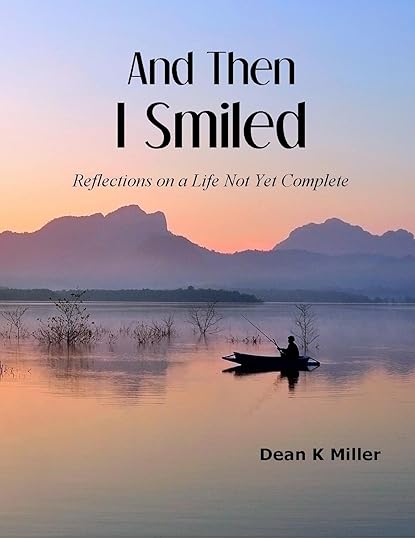 Dean is a freelance writer and member of Northern Colorado Writers. His work has appeared in Chicken Soup for the Soul: Parenthood, TROUT magazine, Torrid Literature Journal and other literary magazines. His essays won three separate contests at www.midlifecollage.com.For 26 years, Miller has kept the skies safe as an air traffic controller for the FAA and received the National Air Traffic Controllers Association (NATCA) Northwest Mountain Region 2010 Archie League Safety Award. In his spare time, he enjoys fly fishing and he is an avid supporter and volunteer for the veteran’s support group Project Healing Waters Fly Fishing. He lives in Colorado with his wife, Laura, and their two dogs, Bear and Snickers.
Dean is a freelance writer and member of Northern Colorado Writers. His work has appeared in Chicken Soup for the Soul: Parenthood, TROUT magazine, Torrid Literature Journal and other literary magazines. His essays won three separate contests at www.midlifecollage.com.For 26 years, Miller has kept the skies safe as an air traffic controller for the FAA and received the National Air Traffic Controllers Association (NATCA) Northwest Mountain Region 2010 Archie League Safety Award. In his spare time, he enjoys fly fishing and he is an avid supporter and volunteer for the veteran’s support group Project Healing Waters Fly Fishing. He lives in Colorado with his wife, Laura, and their two dogs, Bear and Snickers.
Published on April 30, 2014 04:00
April 16, 2014
Writing lessons learned from #WOOL
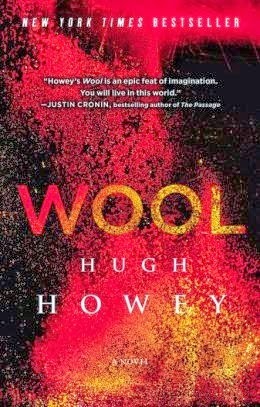
It's been way too long since I've shared some of my writing lessons learned from great fiction! Today I'll gush about WOOL, by Hugh Howey. These notes are based on the omnibus edition of the story, but you can download part one for free here.
First, a brief description of book one:
Thousands of them have lived underground. They've lived there so long, there are only legends about people living anywhere else. Such a life requires rules. Strict rules. There are things that must not be discussed. Like going outside. Never mention you might like going outside. Or you'll get what you wish for.
I've learned some important life lessons from Hugh Howey, like the one I detailed in this post "Are you the Tiger Woods of publishing? Does it matter?" But I also learned amazing writing lessons from his books. (Alert! Read no further if you don't want to know any plot points!)
Keep the secrets coming: the entire WOOL series thrives on the unknown. Why is humanity living underground? When was the silo built? Who built it and why? Who's good? Who's bad? Who's withholding the truth? All these questions kept me turning the digital pages.Provide good reasons for secrets: folks who live in the silo are punished for asking too many questions. Wanna explore the outdoors? Buh bye, you're dead. This provides a great reason why the characters don't know much about their living conditions. They accept their reality and don't dare question it.Give it a rest: WOOL builds tension at a steady pace until soon it's break-neck. But Howey does a great job of giving small rests. For instance, opposite sides start fighting. Bullets fly. While all this happens, we're watching a mechanic fiddle with a radio for communication. It's not much of a rest, but it's there.Build conflict among books & among the series: Howey not only creates tense action and meaningful character arcs within each book, he also does this along the entire series. Stakes rise and conflict builds chapter by chapter, book by book. (By the way, I totally admire writers who write series. What a great skill)Answer a question, introduce a question: just like secrets, Howey doles out questions throughout the entire series. As one question is answered, another is introduced. Readers don't know everything until the final chapter of the last book.Multiple points of view? No problem: most of the series is from one point of view, but many other points of view were expressed when needed. This didn't bother me a bit. It gave me insight to areas of the story the main character wasn't aware of.Have you read any books from the WOOL series? What's your opinion of these writing lessons? Have you used any of these writing techniques? Please share!
My kids are on spring break next week, so I'll skip next Wednesday. The next post will be up April 30th--with a special guest!
Published on April 16, 2014 04:00
April 9, 2014
How to Create a Print Book
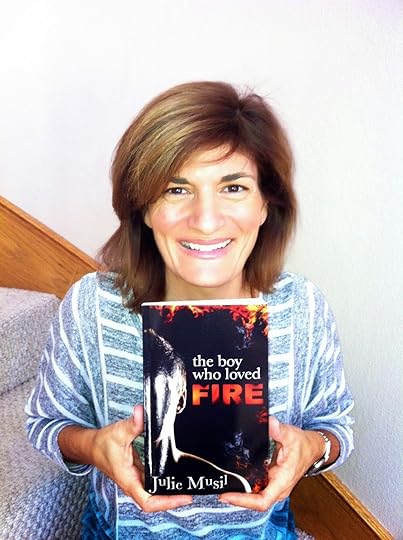 (Here's me holding my proof copy. Almost as exciting as giving birth to my children, and not quite as painful!)
(Here's me holding my proof copy. Almost as exciting as giving birth to my children, and not quite as painful!)Today I'll share how I created my print copy of The Boy Who Loved Fire!
There are many reasons why I think print books are a giant bonus, even in the digital age. I'll share more on that topic in my 4/24 guest post on Janice Hardy's blog. For now I'll discuss the how instead of the why.
For the purpose of this post, I'll focus on CreateSpace--the company I used for my print book. I've been really happy with the outcome.
Here's a step by step guide to creating a print book:
Cover Design
Print covers require a spine and info for the back cover. I used J. Allen Fielder to design all my covers, including print. For a small extra fee, he adjusted my digital cover for print. He knew exactly what to do. All he needed was the book size, page count, and ISBN. This was one of the many benefits of working with a cover pro! If you're working with a cover designer, let them know you're doing print and discuss the details.
Formatting
Before you even sign on to CreateSpace, you'll need to format your final, super duper edited manuscript for print.
Choose a book size: I pulled favorite YA contemporary books off my shelves and whipped out the measuring tape. I chose 5.25" x 8". Another popular size is 6" x 9".Format to size: I write with Apple Pages. I updated my page size in Inspector>Document>Page Setup. (CreateSpace offers help to Word users in this link)Choose margin sizes: I used a ruler to size up my shelved books, then changed the margin settings. In Pages it's Inspector>Document>Facing Pages and >Headers, >Footers.Chapter headings: I moved my chapter numbers to almost mid page of each new chapter. I also increased the font size of the chapter numbers.First lines: remove indent from the first sentence of each new chapter and after each scene break.Delete unnecessary data: remove the table of contents from the front matter, and digital links from the back matter.Save as a .pdf Upload to CreateSpace
Once you have a nifty cover with a spine, and a re-formatted document, you're ready to upload your book. This part moves easily from one step to the next. Here's a short breakdown.Open a CreateSpace account: some of your information from Amazon will transfer over. Everything else is self-explanatory.Title page is self explanatoryInterior: choose paper color (cream is most common for fiction) and type color (black and white). This is also where you upload your .pdf file.ISBN: I chose the free ISBN offered by CreateSpace. For more info about the ins and outs of ISBN numbers, read this post on Janice Hardy's blog.Cover: choose matte or glossy finish (I chose glossy). Upload your cool cover with spine.Complete setup: this is where you review all the info you've entered.Once you've completed all the steps, CreateSpace then reviews your book for quality. You'll receive a message when it's approved.
Review Review your book online: click through each page and see how it will look once printed. Browse through errors: in your online book review, you will likely see errors off to the right. Click through those to figure out what needs to be changed. If you're unsure about these changes, or can't see anything wrong where an error message appears, visit the forums. Many of these "errors" are simply glitches that don't need to be fixed.Proof copy: once you've reviewed your online book and can't find any errors, it's time to order your proof copy. Once you receive your proof copy by mail (a totally exciting experience, by the way), go through each page of the book. Look for anything wonky.Change and re-upload: make any necessary adjustments to your main document, save to .pdf, then upload a new copy. Distribute Channels: I made my book available everywhere.Pricing: I made my book as cheap as CreateSpace would allow. Print books are already more expensive than digital. I wanted it to be as affordable as possible.Description: this is where you add your book summary and author bio.Keywords: very important! If someone wanted to search for your book, what would they put in the search engine? I used teen, arson, hispanic, burn victims, romance. Publish
Once your online book and physical proof have been reviewed for accuracy and beauty, click Publish and get that baby out there!
Yes, print books require additional work, but it's soooo worth it. My biggest advice is this: use the forums. Click here and search for anything you're up against when creating a print book. CreateSpace authors have done and seen just about anything, and they generously share solutions. Forums are an indie author's best friend.
For more tips on self publishing, including ideas for a professional print book, I'd highly recommend James Scott Bell's Self Publishing Attack.
If you're indie or traditionally published, is there a print copy of your book out there? If you've used CreateSpace, or another print service, can you think of anything I've missed?
Published on April 09, 2014 04:00
April 2, 2014
Inspired by a Best Selling Author #IWSG

Welcome, Insecure Writer's Support Group! Clicky clicky here to sign up for this amazing, supportive group.
This month I'm not insecure. I'm inspired.
Have you ever connected with a best-selling author? Until recently, I never had. I'd never sent an email or commented on their Facebook page.
My 17-year-old son and his required reading for AP U.S. History changed all that.
He was assigned to read Hotel on the Corner of Bitter and Sweet by Jamie Ford. My son's plan was to skim through the book and write his essay. I was disappointed and told him how much I'd loved that story, and how he should give the book a chance.
Let me back up. Teens these days are required to read some of the most boring books EVER. No offense to long-dead writers, but their stories are not what interest today's teens. My son has morphed from a book lover to a book dreader, all within a span of three years of high school. Needless to say, he had no plans to enjoy this book. I urged him to at least read the first few chapters and see what he thought. Then I went to bed and left him to his homework.
He stayed up until the wee hours of the morning and finished the book. No joke. He loved this book even more than Hunger Games. After my sleep-deprived son left for school I logged on to Jamie Ford's web site and sent him a message about my son's experience and how much he loved the book.
My son had already tweeted about his love of the book. Jamie Ford retweeted. And he responded to my email within an hour. Since then we've had a nice email exchange about teens, books, and writing. He mailed us each a signed copy of his latest release, Songs of Willow Frost. He even agreed to a blog interview (more about that later). My son noticed that Jamie Ford was doing a library event close to home. Of course we had to go.
What's my take-away from all this? My son got a valuable lesson in giving books a chance. I got a valuable lesson in reaching out to authors, even those who top the best-seller list. They may respond and they may not. I also learned that all authors, whether new or multi-published, like to know when someone enjoys their book.
Jamie Ford inspired me. He took time to reach out to a teen reader. He took time to connect with another writer and answer questions. He's won two lifelong fans.
If you haven't yet read Hotel on the Corner of Bitter and Sweet, I highly recommend you add it to your list. It's an amazing book that still lingers in my heart. And if you love a book, I recommend reaching out to the author and letting them know. Writers--even those at the top of their game--deserve to hear how much their work is appreciated.
Have you ever reached out to a best selling author? Did they respond or ignore you? How did that encourage or discourage you from reaching out again? Do you have teens who dread their required reading?
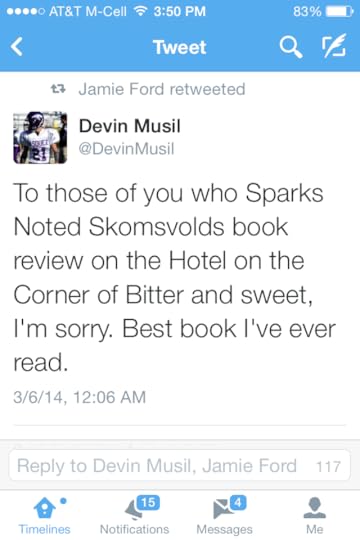 (my son's tweet)
(my son's tweet)
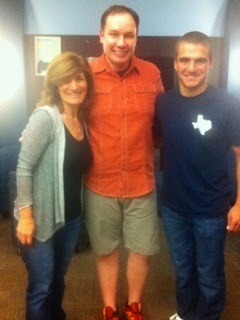 (me, Jamie Ford, and my son)
(me, Jamie Ford, and my son)
Published on April 02, 2014 04:00
March 26, 2014
Publishing a Children's Book: The Large and Small of it

Friends, today we have a guest post by Michelle Houts--one of my agency sisters. As with all of our publishing paths, hers is unique. She's here to share her own experiences with large and small publishers.
Publishing a Children’s Book: The LARGE and small of itSeven years ago, when I finished my first attempt at contemporary middle-grade fiction, I entered The Beef Princess of Practical County in a major publisher’s contest for unpublished authors. I didn’t win. So, I entered it in another: the Delacorte Dell (Random House) Middle Grade Fiction Contest.. Again, I didn’t win. No one did, actually. It was one of the years they didn’t choose a winner. But shortly after, I got a call saying I was a finalist. And, would I be willing to do some work on the novel and resubmit it? Uh, sure? Of course! So, Beef Princess was sold to a Random House imprint without an agent on a second try. Not your typical “how I got published” story, I’ll admit.
The Beef Princess of Practical County won a 2010 International Reading Association Children’s Book Award for Intermediate Fiction. It was Nebraska Farm Bureau’s Children’s Agricultural Book of the Year in 2011. Sales were in the tens of thousands. So, it enjoyed reasonable success, right?
Soon, Beef Princess fans began asking for more. (But my editor didn’t.) Young readers said, “You should write another Practical County story!” (Hmm, my editor didn’t.) School teachers said, “Frannie surely has her own tale to tell!” (But my editor wasn’t asking for Frannie’s tale.) So, I wrote it. And much to my shock and chagrin, guess who wasn’t all that interested? You got it. Random House was not going to publish the sequel. (I know, I know. I’m not the sharpest tool in the shed sometimes.)
After Beef Princess, I landed a fantastic agent, who sold my next middle-grade novel about Danish gnomes at Christmastime (a bit of a leap from cattle farming) to Candlewick Press. That is Winterfrost – due to release 9/9/14. But what about that sequel? My wonderful agent was determined to sell The Practical County Drama Queen. But we were met time and time again with this: It just doesn’t make sense for us to publish a sequel to something we didn’t publish in the first place.
Enter SCBWI – The Society of Children’s Book Writers and Illustrators, an organization I had belonged to for ten years. Their magazine had a story last year on E-First Publishers. These publishers put books out in electronic format first. Then, they may or may not offer a print edition. My agent submitted, and MuseItUp, a small Canadian publisher, offered an electronic AND print contract right away. Frannie’s tale would be told!
The Practical County Drama Queen was released January 31, 2014 in electronic formats. In the spring, it will be released in paperback. So, what’s the difference between publishing with a large, well-known publisher and a tiny upstart? There are several, but first let me say that both fall within the realm of TRADITIONAL publishers. Both are royalty-paying publishers in which the author pays nothing. From there, things can go in different directions. For example, my advance with a large publisher was many, many times that of a small publisher. My royalty rates, however, are larger with the small publisher, and guess what? There’s no giant advance to earn back before royalties kick in! With a large publisher, I dealt with many “faces” (most of which I’ve never met) in many departments, doing many jobs on my behalf. With a small publisher, there are just a couple of folks who do it all. I got to know them well, and rapport developed quickly. But this also means that without a marketing person and a publicist assigned to my book, I’ll be fronting more of the responsibility.
It’s too early to compare sales, awards, successes. I imagine this title will be a little more obscure in the big book world than its predecessor was. But, it’s published. And, now, when a 4th grader emails to beg for another Practical County tale, I can tell them it’s done!
Thanks, Michelle! It's fascinating to hear about the winding paths of our fellow writers.
Friends, have you written or published a sequel? Was the sequel written in response to reader requests? Have you ever published a sequel with a different publisher than the first title? Please share!
Michelle Houts lives and plays on a family farm in Ohio with her three children, the famer of her dreams, some cattle, hogs, a whole lot of barn cats, a few goats and a dog named Hercules. She enjoys reading, cooking and hiking any place that has hills because it is very flat where she lives. An eternal student, Michelle has degrees in special education and speech-language pathology. For more about Michelle Houts and her writing journey, visit www.michellehouts.com.
If you'd like more information about small publishers, check out the guest post by Alex J. Cavanaugh: In the Middle--The Small Publisher Debate.
Published on March 26, 2014 03:00
March 19, 2014
Harry Potter--The Science Behind the Magic
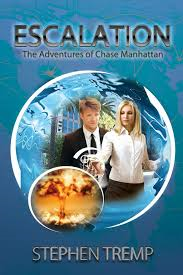
Friends, be sure and stop by Crystal Collier's blog. I'm hanging out over there, sharing two truths, one lie, and other fun information.
Today we're doing something a little different. Super nice and super smart Stephen Tremp is here to share the science of Harry Potter using E=Mc2. I should mention that science was always my worst subject. I've only had one C on my report card. Guess which subject? Yep. Science.
Just for fun, let's hear how an epic duel between Dumbledor and Voldemort could've really happened. Take it away, Stephen!
The Science of Harry Potter using E=Mc2My “thing” is to converge science and the supernatural, using Einstein’s famous equation E=Mc2. This will help make sense of our universe. According to me, at least. In the Harry Potter series, there is much magic that allows for spectacular settings and scenes, both in the books and the movies. But can there really be any science behind the magic? Let’s take the epic duel in Order of the Phoenix between Professor Dumbledore and Lord Voldemort in the atrium of the Ministry of Magic.Albus Dumbledore: "It was foolish to come here tonight, Tom. The Aurors are on their way —" Voldemort: "By which time I shall be gone, and you dead!" — Dumbledore and Voldemort taunt each other briefly prior to the duel
So how can these duelers make fireballs of death and water prisons out of small insignificant sources of fuel? Enter =Mc2: Einstein’s iconic equation. The equal sign means just that. Equal. One side equals the other. So energy is the same as matter times the speed of light squared. That’s a lot of energy if you take a moment to think about it. Okay, but what does that mean? Think of Hiroshima and Nagasaki. Both bombs released less than two percent of their total potential energy. And just think of the mass destruction they caused. That being said, what if the bombs released one hundred percent of their energy?Your Assignment: Google “Mass To Energy Calculator” and try it out. For example, 100 pounds of mass, should it be able to release all of its energy, would be the equivalent of close to 1,000 megatons of TNT!Here is one such link: CLICK HERE and scroll down to the Energy To Mass Calculator and give it a try.
So perhaps Dumbledore and Voldemort weren’t just waving wands and magically making things out of nothing. They could simply be using the potential energy of nearby objects such as fire and water to make awesome weapons by converting mass to energy and energy to mass.
Thanks, Stephen!
See what I mean about smart? Stephen even makes me think science is fun.
Tell me, friends, are you fascinated by science? Or were you like me and got a C and never wanted to take that class again? Have you ever wondered how story scenes could've possibly happened for realz? Please share!Stephen Tremp is the author of the Breakthrough series. Together, Breakthrough, Opening, and Escalation follow the lives of the unlikely participants from innocence to a coming of age through sacrifice, betrayal, passion, lust, unconditional love, and hope. Escalation will appeal to fans of modern-day science fiction, action, horror, and even romance.
Stop by Stephen’s Blog for more information on the Breakthrough series. To download Escalation: The Adventures of Chase Manhattan CLICK HERE.
Published on March 19, 2014 03:00
March 12, 2014
Indie Roundup #indielife

Before I get to the indie roundup, I wanted to let you know that I'm giving away print copies of The Boy Who Loved Fire over at Goodreads. See that link on the sidebar? Clicky clicky and enter for your chance to win a signed copy :)
When I released my YA novel, The Boy Who Loved Fire, I was fortunate enough to guest post on some amazing blogs. I posted those links on my author Facebook page, but not here. Today, as my contribution to IndieLife, I'll remedy that.
If you're on the fence about indie publishing, if you think it's too intimidating, or if you want to know how a complete newbie like me could pull it off, I hope you'll find these posts helpful.
Self Publishing
A Newbie's Guide to Self Publishing @ Jami Gold's blogResources for the Do-It-Yourselfer @ Elizabeth Spann Craig's blogLessons Learned from Self Publishing @ Janice Hardy's blog
Writing Advice
Softening Hard Characters to Make Them Likable @ Writers Helping Writers blog
Inspiration
Artistic Bravery @ Adventures in YA Publishing
Interviews and Features
Book Reviews--why they matter and how to write them @ Leslie Rose's blogMy 3 most important elements of writing, plus how I describe myself using fruits, veggies, and movies @ Sheri Larsen's blogWhy I decided to self publish, plus writing advice @ Carol Riggs' blogWriting advice and insight to my favorite cartoon character @ Marcy Hatch's blogFlawed characters and why we love them @ Tina's Book ReviewsWhat inspired The Boy Who Loved Fire? @ Unconventional Librarian
If you stopped by any of these blogs, thank you! If you've read some amazing posts recently, please share them in the comments.
Have you indie published? If you've released a book, did you do a blog tour? What lessons did you learn?
Published on March 12, 2014 04:00
March 5, 2014
Grateful for the Long Road #IWSG

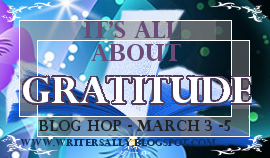
Hello, friends! Today I'm participating in Alex J. Cavanaugh's brilliant brainchild, Insecure Writer's Support Group, and Sheri Larsen's It's All About Gratitude blog hop.
I'm also featured at The Artist Unleashed on Jessica Bell's blog. Stop by and chat about how we mature as writers. Cuz I'm mature :)
Is it possible to be insecure and grateful? Sure! Let me explain.
On Valentine's Day, Super Supportive Hubby and I took a romantic ride in a horse-drawn carriage on a moonlit night. He gazed lovingly at me as I cradled long-stemmed roses in my arms.
Just kidding. That is soooo not us!
Instead, we spent the day hiking the jagged peaks of Vasquez Rocks--cool rock formations near our home (seen in Roswell, The Flinstones, and Star Trek: The Next Generation). We've hiked there several times before. Hubby wanted to branch out on a new trail. I was game.
We took a long, meandering trail shaded by overhanging trees. We were like the So Cal Lewis and Clark, exploring new surroundings. I loved it. By the time we reached our destination, we were hungry, hot, and tired. We'd planned lunch at the local Mexican restaurant. I was having visions of mango margaritas. Forget Lewis and Clark. We needed to get back to our car, stat.
Hubby's solution? A shortcut! Less distance, less time. Brilliant. True, the distance was shorter, but the climb was straight up. Hard work when you're seeing mirages of mango margaritas. Hubby had to push and pull me in certain places. I didn't care about the beautiful surroundings. I just wanted to get to the end.
What did I learn? I like long, meandering roads much better, where I'm focused on the view and not the destination.
Same with my writing road. I'm grateful my journey has not been rushed. I'm grateful I didn't get what I wanted when I wanted it. I'm grateful I've had time to learn and grow along the way. I'm still insecure about each fork on the trail, but I'm grateful for the long road. I can walk, run, take detours, stumble, and fall. Things have a way of working out the way they should.
What else did I learn?
Mango margaritas are worth the wait.We must choose the right paths for ourselves.Beware the man who says, "Let's take a shortcut."If you're a hiker, do you like long roads or shortcuts? How about with your writing life? Please share!
Published on March 05, 2014 04:00
February 26, 2014
Digging for Gold on Goodreads—Guest Post by Stina Lindenblatt
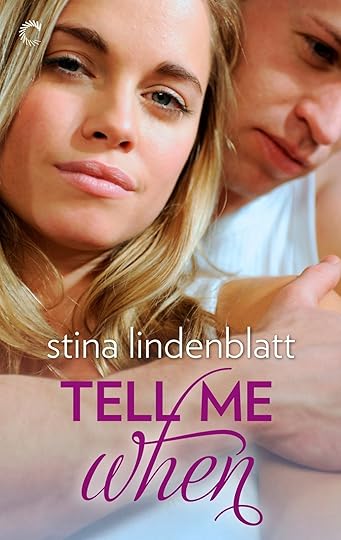
I'm relatively new to Goodreads, and I'm still getting my bearings there. I've thought of it as a way to see which books I'd like to read, but hadn't thought of the reviews as a way to improve twists in my own fiction.
Today Stina Lindenblatt, author of the NA novel Tell Me When , is here to share how authors can learn from Goodreads reviews. It's all yours, Stina!
Digging For Gold On Goodreads
When my debut novel went live and reviews started popping up on Goodreads, I refused to read them. I was terrified that everyone would hate the book. I eventually found the courage to peek at them and found a gold mine of information.
I’m not talking about great reviews saying that I’m the next J.K. Rowling (which there were none, though that would have been fantastic). The reviews I’m talking about are the ones that dissected the tropes I used in my story. These reviewers took the time to analyze what I did right with the tropes and explained why they loved my twist on them. Some reviewers had actually requested the book off NetGalley because they disliked the trope. This just meant they were super critical and were waiting to be surprised.
It dawned on me that reading the reviews for both my book and others in my genre can benefit my writing. When you study reviews like these, you learn what it is about certain tropes that irritates readers, what tropes they feel are overdone, and what books deal with them in a different way that make them fresh. When you apply this knowledge to your own stories, it helps you avoid the “I’ve read this same story a million times” reviews. This will also help you gain agent and editor attention. Like readers, these individuals are craving fresh stories. They’re craving your fresh story.
Have you used Goodreads to help you improve your stories?
Amber Scott should be enjoying life as a college freshman. She should be pursuing her dream of becoming a veterinarian. She should be working hard to make sense of her precalculus math class.
She shouldn’t be waking up her college roommate with screaming nightmares. She shouldn’t be flashing back, reliving the three weeks of hell she barely survived last year. And she definitely shouldn’t be spending time with sexy player Marcus Reid.
But engineering student Marcus is the only one keeping Amber from failing her math course, so she grudgingly lets him into her life. She never expects the king of hookups will share his painful past. Or that she’ll tell him her secrets in return, opening up and trusting him in a way she thought she’d never be able to again.
When their fragile future together is threatened by a stalker Amber thought was locked away for good, Marcus is determined to protect her—and Amber is determined to protect Marcus…even if that means pushing him away.
Thanks, Stina! I think I'll do a little mining over at Goodreads.What about you all? Do you mine Goodreads reviews for fresh ideas? Any tips you can share?
Stina Lindenblatt writes New Adult contemporary romances and currently lives in Calgary with her husband and three kids. When she isn’t writing, lost in a romance novel, or checking out romantic photos, Stina loves to spend her free time behind the camera lens. She can be found on her website, Twitter, Facebook, and Pinterest.
Available: Amazon Barnes & Noble
KOBO
Published on February 26, 2014 05:30



